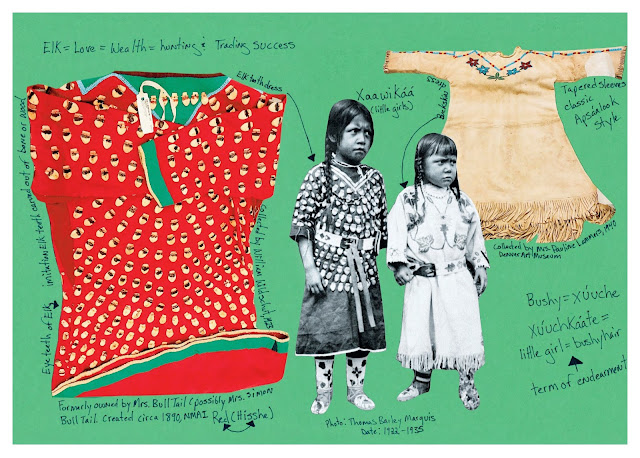 |
Bíilukaa by Wendy Red Star.
|
Photographs by Wendy Red Star
Radius Books, Santa Fe, NM 2023. 224 pp., 140 color images, 9½x12½".
In conversations about contemporary Native American photographers, Wendy Red Star, an Apsáalooke multimedia artist, is often among the first referenced. I must admit that, until now, I have overlooked her practice and her layers of contribution to the fields of art history, oral history, archival studies, and remix studies, among others. Having spent time with her artist’s book Bíilukaa, I understand her to be an intellectual visual scholar with a commitment to visual sovereignty — to revitalizing the collective ability of Indigenous people to exercise creative tribal autonomy and self-determination. In Bíilukaa she demonstrates this in meaningful and productive ways using Native art, histories from the archive, and deeply personal family memories.
Every aspect of Bíilukaa (a reference to what the Apsáalooke call themselves: Our Side) feels intentional. Each page is created with thoughtfully selected paper. The subtly textured, off-white pages, bound with multicolored stitching visible in measured peeks, create a sensory dialogue between material culture and Apsáalooke history, taking place somewhere between a family photo album and archival enclosures. Vellum pages with text are rhythmically placed between visual art and sentiments related to family and history.
 |
In what might be considered the equivalent of a foreword, Red Star situates two short paragraphs on the eleventh page. Opposite this text is the outline of a floral beadwork pattern, with a few long binding stitches between the pages. In contrast to the brightly colored, energetic spreads to follow, this one is, visually, almost silent. She writes: “To be bíilukaa implies not only common heritable ancestry but, more importantly, a community bound by language, spiritual beliefs, and social structures . . . [the book] reveals and gives new form to what I have found during my research in public collections and archives while also honoring and connecting those materials to my family and community.”
 |
 |
Bíilukaa presents five transcribed conversations between Red Star and her parents, her sister, and art curators alongside and within a colorful reimagining of an archival milieu. Using this general framework, the artist opens photographic and two-dimensional archives to new methods of place-based, land-centered, conceptual frameworks for art and its history. Through art making and archival re-imaginings, Red Star is examining forms of visual culture from specific periods in American history more broadly and within the Apsáalooke tribe more specifically. In many ways Bíilukaa is both private and public, a family memoir and a postcard from an archival vault. Its aesthetic and intellectual arrangement is intended to displace the narratives of Red Star’s community that have been shaped by U.S. history and popular American culture, and to assert Indigenous continuance and survival. There are no tropes of “traditional vs. modern,” anywhere in sight; they are brilliantly woven together throughout, as if existing all at once. The effect is a book that is expressive, complex, and creative. In this way, Bíilukaa is brilliant in its form, expressiveness, complexity, and creativity.
 |
With this book, Wendy Red Star makes a critical and original contribution to the ways Indigenous visual arts are presented. Bíilukaa centers on relationships and personal family memories without depending on sentimentality. It is true to history without depending on empathy. Its conversations are a template for what oral histories can be when they are taken outside of established methodologies and reimagined as something altogether different. There is a complexity in Bíilukaa that leaves much of it unavailable to us. I am unable to fully embrace its meaning, yet I deeply valued the aesthetic experience. Bíilukaa is a treasure, a gift that will undoubtedly be cherished by Red Star’s daughter and appreciated by the rest of us for years to come.
Purchase Book
Read More Book Reviews
 |
 |
Marcella is Ojibwe. She is Gunflint Lake Chippewa and an enrolled member of the Bad River Band of Lake Superior and has heritage that includes Eastern European ancestry. Marcella is a Native feminist theorist of visual culture, sound studies and contemporary art. Her archival research and processes of historical interpretation has led to explorations of visual textures combined with audio experiments. Currently, her work draws from oral histories and family photos as sites of memory and open-ended reflections on politics of place, and the varying relationships between social art history, gender, and Indigenous land justice. Marcella holds a PhD in American Studies and is currently an Assistant Professor of Native Art History with the Department of Art Studio, History and Education at the University of New Mexico.









